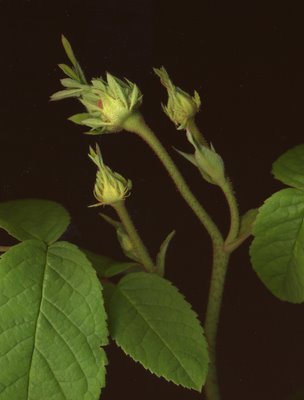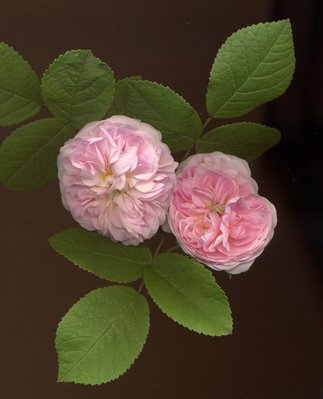The French Go Gaga For Ancient Egypt
Friday, May 25, 2007

I waited from 6:30 until 1pm and was then admitted into the pre-op room of the Vancouver General Hospital. I inserted my belongings in a couple of plastic bags and put on my hospital-issue clothing. At around 2, Doctor O'Brien informed me it was a "no go" and that I was to return tomorrow at 11. Roaming the garden I noticed that Rosa 'Belle Isis' (left and below) is full of buds and that some will open over the weekend. I started to think about Egypt.
The French (and England and much of the world) went gaga for ancient Egypt and its artifacts because of Napoleon's campaign in 1798. In 1799 the French founded Institut de l'Egypte in Cairo which brought many scientists and archaeologists to the region. But it was French Army engineer Captain Pierre-François Bouchard, who discovered the Rosetta stone on July 15, 1799, while guiding construction work at Fort Julien near the Egyptian port city of Rosetta (now Rashid) which started the rush for Egyptian bric-a-bracs and furniture. It became a stampede when Jean-François Champollion finished the translation of the stone in 1824. In 1802 when the French troops surrendered to the British in Alexandria and Cairo they lost possession of the Rosetta stone. By a wonderful coincidence (but not to the French) the stone was taken back in 1802 to England and to the British Museum in the captured French frigate L'Egyptienne.
By 1845 there was a rose named after the Egyptian goddess of love, beauty and wisdom in Rosa 'Belle Isis'. There was nothing really unusual about this pink Gallica (many guess she's part Alba, too.), which blooms only once in the season, as there are many other similar Gallicas.

What made this rose unique was its scent of myrrh. The only other rose with this original scent at the time was Rosa 'Splendens' sometimes called Rosa 'Ayrshire Splendens' which was a mutation of the species rose, the only scrambling rose native to Britain, Rosa arvensis. Many hybridizers suspect that Louis Parmentier's Belle Isis must have Splendens in its parents.
In 1961 David Austin crossed Belle Isis with Dainty Maid and produced his first English Rose, Rosa 'Constance Spry' which is powerfully fragrant of myrrh.
Such is my obsession for myrrh that I have in my garden Rosa 'Splendens', Belle Isis (which I obtained from John Tuytle, Constance Spry and many more English Roses including Fair Bianca.
The unusual can be found just about anywhere in a garden if you happen to look closely. Belle Isis's buds are fit for the goddess of beauty, love and wisdom, are they not?






